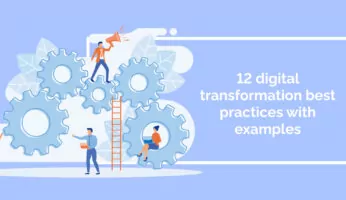
At some point, every business comes across the issue of whether or not they should make a change.
In many cases, this question is prompted by pressure from outside.
For instance:
- Customer expectations change
- Digital innovation drives continual changes in the marketplace
- Crises, such as financial crises or COVID-19, affect every aspect of the economy
All of these types of changes, as we’ll see below, are valid reasons to make a change in your business.
5 Reasons Why You Should Make a Change in Your Business Today
Here are some of the most compelling reasons why you should study the principles of change management and invest in change, starting today:
1. Digital disruption is shifting the way we do business
Digital innovation has been radically altering the economy for years.
That trend has not slowed and it will not slow for years to come.
In fact, many expect to see even more dramatic changes, fueled by technology such as:
- Artificial intelligence (AI)
- Automation
- The blockchain
- Augmented reality (AR) and virtual reality (VR)
- The Internet of Things (IoT)
- 3D printing
These are just a few of today’s emerging technologies that are expected to become the norm in the years ahead. As they reach widespread adoption, expect to see massive changes to the economy, the way we live, the way we work, and the business landscape.
2. COVID-19 has permanently changed the workplace
Organizations in every corner of the world felt the impact of COVID-19.
In most cases, surviving and succeeding required adaptation – employees worked from home, employers changed marketing tactics, businesses shut down physical offices, and so forth.
Although recovery is expected, it is important to recognize that we’ll be recovering to a different economy and a different work environment.
Many research firms dub this the “new normal” or the “next normal,” a different paradigm that will feature changed customer expectations, work conditions, and more.
To survive and thrive in this new business environment, it is crucial to begin adapting as early as possible.
3. Customer preferences are changing
Customer preferences are always changing, but today, they are changing faster than ever.
There are several reasons for this, including:
- Digital disruption
- Crises, such as financial crises and COVID-19
- The passage of time
- Cultural shifts
- Geopolitical events
Naturally, every business will be affected differently by changes such as these. In some instances, these types of trends will have a greater impact, and in some instances, a lesser impact.
It is important to monitor the various factors that will influence your customer base, then adapt your business strategies accordingly.
4. Business practices are changing
Another ongoing trend is the change to business practices.
Over the past several decades, for instance, we have seen the rise of systematic process improvement and performance improvement methodologies, such as:
- Agile
- Lean
- Six Sigma
- Total Quality Management
These types of business methods, when applied correctly, can generate significant bottom-line benefits, from improved employee productivity to less waste to cost savings.
As a result, those companies who are willing to adopt such practices will stand a better chance of outperforming their competitors – and those that do not will fall behind.
5. Winning in tomorrow’s economy requires change
Ultimately, companies that can adapt to today’s changing business world will be those most likely to stay profitable in the years ahead.
While change is an investment that carries risk, as McKinsey pointing out, parking on the side of a volcano is riskier than moving elsewhere – even if moving requires change.
Since, as we have seen, tomorrow’s economy will be built upon change, tomorrow’s winners will be those most ready to adapt.
Leaders in the post-COVID digital era, for instance, will put digital technology at the heart of their business models, their culture, the customer experience, and their employee experience.
Those that can’t keep up with the accelerating pace of change, however, will fall further and further behind and, ultimately, phase out of the digital future.
Where to Begin?
Change is definitely not easy and many people resist change – change, after all, can be scary, difficult, and the outcomes uncertain.
Yet, as mentioned, the risk of not changing in today’s world is often greater than the risk of making a change.
One of the best ways to overcome the daunting challenges of making change is to understand what organizational change means, learn what its challenges are, then find ways to overcome those challenges.
Here are a few tips for doing just that:
- Learn the top theories of change management, such as the Kotter change model
- Understand why employees resist change, then find ways to reduce that resistance
- Provide ample training to employees before, during, and after a business change
- Make a case for the value of business change and earn commitment from business leaders
- Invest in digital transformation, digital maturity, and digital adoption
- Adopt new business models, such as agile and lean, to stay ready for unpredictable changes to the marketplace
A comprehensive organizational change strategy is most likely needed to stay relevant in tomorrow’s world. While that may understandably be daunting and difficult, making such a change will be well worth the investment – and it may be ultimately essential for survival in tomorrow’s business world.
WalkMe Team
WalkMe spearheaded the Digital Adoption Platform (DAP) for associations to use the maximum capacity of their advanced resources. Utilizing man-made consciousness, AI, and context-oriented direction, WalkMe adds a powerful UI layer to raise the computerized proficiency, everything being equal.



